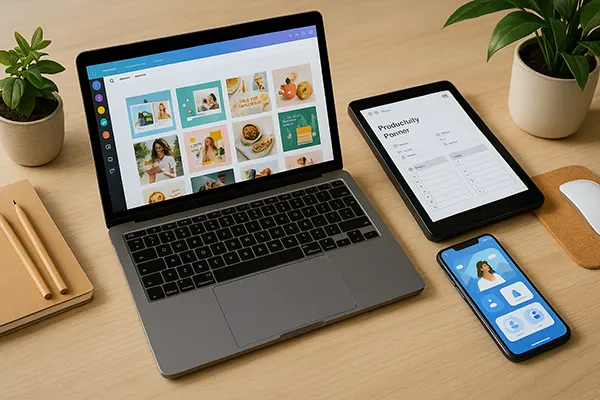
Visual Income: How to Sell Templates for Canva, Notion, Figma Without Designing From Scratch
Monetising your creativity online doesn’t always require advanced design skills. In recent years, thousands of digital creators have successfully built passive income streams by selling pre-made templates for tools like Canva, Notion, and Figma. These templates help people save time, improve productivity, and present their ideas more clearly — making them highly desirable digital products. If you’re wondering how to join this niche without being a professional designer, this article is for you.
Understanding the Demand for Ready-Made Templates
Ready-made templates have become a valuable commodity for online users, entrepreneurs, teachers, and social media managers. Canva templates are used for social media graphics, marketing materials, and e-books. Notion templates help organise tasks, journals, goals, and team workspaces. Figma templates serve UI/UX designers looking for structure and inspiration. The demand is driven by the need for efficiency, simplicity, and professional-looking materials without the overhead of hiring a designer.
According to Statista, the global digital downloads market, including templates, is projected to grow steadily, reaching over $60 billion by 2025. This trend shows the potential for long-term, scalable income. Buyers are willing to pay for time-saving solutions, which is why unique and well-organised templates continue to perform well on marketplaces like Etsy, Gumroad, and Ko-fi.
What makes this niche attractive is the low startup cost and ease of entry. You don’t need to be a graphic designer or developer. You can use existing design tools and licensed elements to assemble attractive layouts. Moreover, automation tools and AI-based content assistants allow even beginners to polish their product before launch.
Who Buys Templates and Why It Matters
Knowing your audience is the first step to successful sales. Small business owners often look for marketing kits and Instagram post layouts in Canva. Students and professionals favour Notion planners and productivity boards. Figma templates are in demand among junior designers and startups for prototyping apps and websites quickly. By understanding the users’ needs, you can create value even without advanced design input.
Many template buyers are non-technical users. They look for products that are easy to use and can be edited with a few clicks. Therefore, it’s essential to focus on clear navigation, instructions, and logical structure in your templates. The better the user experience, the higher the chances of positive feedback and repeat customers.
It’s also worth noting the importance of localisation. English remains the dominant language, but niche creators who offer templates in other languages often find success in under-served markets. Including multilingual elements or region-specific formats (e.g., academic calendars or business templates by country) can give your offer an edge.
Creating Templates Without Design From Scratch
You don’t need to start every design from a blank screen. Many tools offer free starter templates or drag-and-drop interfaces. In Canva, you can edit pre-designed layouts and replace content with your own. Figma allows users to duplicate and modify open-source wireframes and components. Notion creators can assemble databases and pages using basic blocks and pre-built structures provided by the platform itself.
Licensing is key. Always ensure that the assets you use (fonts, icons, illustrations) are permitted for resale. Canva Pro users, for example, have access to elements they can use in templates for resale, but each marketplace may have different rules. Read the licensing agreements carefully to stay compliant.
Once your templates are created, packaging matters. Include clear naming, folders, instruction files, and a PDF or Notion link that explains how to use the product. Templates that look organised and come with guidance tend to be rated higher and recommended more often.
Tools and Resources to Streamline the Process
Start with free design assets from websites like Unsplash (for images), Icons8 (for icons), and Google Fonts. Use these to enhance your template’s visual appeal. For more advanced users, tools like Figma Community, Notion Template Gallery, and Canva Creator allow you to share or sell your designs directly.
AI writing assistants (such as ChatGPT) can help generate example texts or category descriptions. Tools like Loom can help you create short demo videos to explain how to use your templates. These extras significantly improve your product’s quality and credibility in the eyes of buyers.
Additionally, you can use marketplaces like Etsy and Creative Market, or no-code tools like Gumroad and Lemon Squeezy to host your shop. Combine them with social media promotion or build a small website using Carrd or Notion pages to introduce your brand and gain followers.

Pricing and Marketing Strategy
Pricing digital templates requires balance. Low prices can attract more customers but undervalue your work; high prices can reflect the quality and perceived value but may deter first-time buyers. Start with market research: analyse top sellers in your niche and look at their price points. Then test multiple tiers — single template, bundle, and premium versions with extra features.
Marketing can begin with content creation. Share videos of how to use your templates on TikTok, Instagram Reels, or YouTube Shorts. Join design and productivity communities on Reddit, Discord, and Facebook to offer helpful advice and link to your products organically. Email marketing is another powerful way to promote new releases to your customer base.
Consider offering freebies to build trust and grow your audience. Many successful creators use lead magnets — one free Notion planner or a Canva Instagram post pack — to encourage newsletter subscriptions. Over time, these followers convert into paying customers and can become your most loyal buyers.
Building a Sustainable Passive Income
Passive income from templates isn’t 100% passive — it requires updates, support, and occasional redesigns to stay relevant. However, once your products are listed and marketed effectively, they can generate consistent revenue with minimal daily involvement.
Use analytics tools provided by Etsy, Gumroad, or Google Analytics to track what sells best and where traffic comes from. This data helps you optimise future products and focus your efforts on high-performing niches. Continue learning from your audience — read reviews, respond to comments, and improve with each iteration.
To scale up, consider collaborating with other creators or hiring a VA (virtual assistant) to help with repetitive tasks. With time, you can build a small brand with recognisable style and value, leading to stable, reliable income every month.
